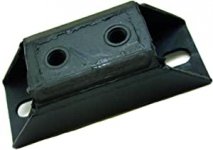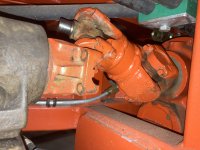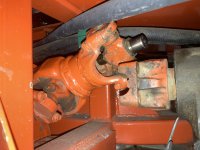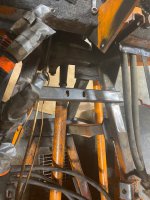-
Please be sure to read the rules and adhere to them. Some banned members have complained that they are not spammers. But they spammed us. Some even tried to redirect our members to other forums. Duh. Be smart. Read the rules and adhere to them and we will all get along just fine. Cheers. :beer: Link to the rules: https://www.forumsforums.com/threads/forum-rules-info.2974/
You are using an out of date browser. It may not display this or other websites correctly.
You should upgrade or use an alternative browser.
You should upgrade or use an alternative browser.
1975 Tucker 1544 - project and trips
- Thread starter YamaDooPolCat
- Start date
I stumbled upon a youtube video of this Tucker in action. The music is "less than optimal" :
Plenty of stock form and function in that video.
Haha! That was a cool video. What music?
I located and bought a 727 with a short tail stock. I finally get to measure a 727 and the total length is about 26.5" - which is about the same as the 5 speed, so we are happy.
I had to buy the 1977 360 motor as well, but I needed a few motor pieces anyway. Like exhaust manifolds for one.
The exhaust manifolds on both engines need to be planed down to use as the center of the manifold in down quite a bit and the exhaust leaks. You can see the exhaust streaks. No exhaust gaskets??
Tomorrow I hope to bolt up the 727 to the 318 and dry fit to work on supports for the back of the automatic.
I'm pretty happy that the 360 exhaust manifolds fit right on.




I had to buy the 1977 360 motor as well, but I needed a few motor pieces anyway. Like exhaust manifolds for one.
The exhaust manifolds on both engines need to be planed down to use as the center of the manifold in down quite a bit and the exhaust leaks. You can see the exhaust streaks. No exhaust gaskets??
Tomorrow I hope to bolt up the 727 to the 318 and dry fit to work on supports for the back of the automatic.
I'm pretty happy that the 360 exhaust manifolds fit right on.
I took the radiator to the rad shop to be checked as it is very green looking. Not something I would take far from home.
The fellow at the rad shop says he doubts there is enough room to install a rad cooler in the bottom tank.
Which brings up the WTF question.
What have the Tuckers with automatic transmissions been using for tranny coolers???
The fellow at the rad shop says he doubts there is enough room to install a rad cooler in the bottom tank.
Which brings up the WTF question.
What have the Tuckers with automatic transmissions been using for tranny coolers???
Could someone that has any pictures of the Tucker radiator with the bottom tank showing the automatic transmission cooler fitting, please post them here. The rad shop is probably going to phone me tomorrow, so I'd like something to show the guy.
That is IF the Tucker did use the bottom tank for the automatic cooler.
Thank you.
That is IF the Tucker did use the bottom tank for the automatic cooler.
Thank you.
Mine as far as I know and can tell has the original rad I boiled mine out with some cleaner and it looks perfect I think the older rads were made of better /thicker copper and brass. My rad does not have a radiator cooler in the tank it has an external one mounted in front of the rad. The 727 trans stays nice and cool with the external cooler maybe this was how they were set up origionally or the autos came with a different rad /tank combination. I wish I was closer I would like to have that np541 you took out they have a very low first gear and work well in other machinery used for the woods My 318 had a set of blockhugger headers on it they fit nice and close and seemed to work well for the purpose
Ha! You had very successful maiden voyage. I hope mine is the same!
I suspect you are correct and the Tuckers didn't have a transmission cooler in the rad tank.
I suspect you are correct and the Tuckers didn't have a transmission cooler in the rad tank.
I trust the guy that is going build the 727 for me, but I was wondering if anyone has the specs for the guts in the 727 ?
I did my own transmission they are really not that complicated and with the updates now available as they have found all the weakneses they end up pretty bulletproof. The only thinh I had some issue with was the governor I needed to use one from a diesel to shift at the low rpm as mine is goverened at 2200 and the gas one would not work correctly, i was aware of this when i was building it The chyrsler industrials and I think tucker recommended the gas engine not be operated over 3500RPM I dont know if modifications to the governor will have to be made to keep the shifting and line pressure in the transmission correct may be something to mention to your trans guy
Thanks for the info, and I was thinking about that 3500 max rpm as well.
But that will be up to the tranny guy.
Got the engine and 727 bolted together for a dry fit, and locate the back cross member.
We could not get that stubby drive shaft to fit, it seems to be too long. So measured the 5 peed and 727 again and they come out identical in length. I have to find a yoke to fit the 727 end anyway, so I guess that mystery will wait for another day.
But that will be up to the tranny guy.
Got the engine and 727 bolted together for a dry fit, and locate the back cross member.
We could not get that stubby drive shaft to fit, it seems to be too long. So measured the 5 peed and 727 again and they come out identical in length. I have to find a yoke to fit the 727 end anyway, so I guess that mystery will wait for another day.
My gosh, no grass grows under your feet. You’re like the Energizer Bunny…on steroids! Very impressed with the speed of your project.
From reading your posts it seems you're taking the transmission and associated parts from the 360 and installing them on the 318. My concern with that is you may be unknowingly making a mistake, and I’d hate for you to discover it after the fact, and have to pull the engine and transmission to rectify it.
While the 318 and 360 engines are both from the same LA engine family, there are some differences. The 318 is an internally balanced engine and the 360 is externally balanced. A 318 requires neutrally balanced harmonic balancers and flywheels, whereas a 360 requires counter-weighted components. Mixing the two will cause unhealthy vibration issues. I have considerably more experience with GM and Ford engines than Chrysler, so please accept that as a disclaimer. I THINK the setup Chrysler used on the 360 is a neutrally balanced flexplate and a counter weighted torque converter. That would mean you would need a torque converter made for a 318. But, please confirm this with someone far more knowledgeable than I.
Our 1986 Tucker 1544 came with an AT545 from the factory, and Tucker installed a 12” x 24” Hayden brand fluid cooler in front of the radiator to cool the transmission fluid.
With regard to the the 3,500 RPM limitation... here’s my theory:
Tucker used/uses Vickers V20P hydraulic pumps and Vickers has a maximum recommended RPM for their pumps. It changes based on the pumps volumetric output, but 2,500 RPM is a good baseline number. Tucker under drives the hydraulic pump with the geometry of the V-belt pulleys. IIRC, Tucker uses a drive pulley (mounted to the harmonic balancer) that’s 6” in diameter and the driven pulley (on the hydraulic pump) is 8”. Mathematically, 3,500 engine RPM would equal 2,625 pump RPM, a bit more than the maximum recommended by Vickers, but not egregiously so.
From reading your posts it seems you're taking the transmission and associated parts from the 360 and installing them on the 318. My concern with that is you may be unknowingly making a mistake, and I’d hate for you to discover it after the fact, and have to pull the engine and transmission to rectify it.
While the 318 and 360 engines are both from the same LA engine family, there are some differences. The 318 is an internally balanced engine and the 360 is externally balanced. A 318 requires neutrally balanced harmonic balancers and flywheels, whereas a 360 requires counter-weighted components. Mixing the two will cause unhealthy vibration issues. I have considerably more experience with GM and Ford engines than Chrysler, so please accept that as a disclaimer. I THINK the setup Chrysler used on the 360 is a neutrally balanced flexplate and a counter weighted torque converter. That would mean you would need a torque converter made for a 318. But, please confirm this with someone far more knowledgeable than I.
Our 1986 Tucker 1544 came with an AT545 from the factory, and Tucker installed a 12” x 24” Hayden brand fluid cooler in front of the radiator to cool the transmission fluid.
With regard to the the 3,500 RPM limitation... here’s my theory:
Tucker used/uses Vickers V20P hydraulic pumps and Vickers has a maximum recommended RPM for their pumps. It changes based on the pumps volumetric output, but 2,500 RPM is a good baseline number. Tucker under drives the hydraulic pump with the geometry of the V-belt pulleys. IIRC, Tucker uses a drive pulley (mounted to the harmonic balancer) that’s 6” in diameter and the driven pulley (on the hydraulic pump) is 8”. Mathematically, 3,500 engine RPM would equal 2,625 pump RPM, a bit more than the maximum recommended by Vickers, but not egregiously so.
Here is a picture of my driveshaft I don’t have measurements but you could estimate it pretty close. This was from when I was setting it up with the 4bt and diesel 727 transmission
Attachments
Thanks for chiming in, I appreciate the info. I noticed the 360 had a balanced torque converter, but was going new anyway on that part. The parts I was going to use was the starter, as I need a two bolt now. The exhaust manifolds because I have a broken one. I had the exhaust faces planed at the machine shop as the center port on all the manifolds 318 nad 360 were warped and leaking.My gosh, no grass grows under your feet. You’re like the Energizer Bunny…on steroids! Very impressed with the speed of your project.
From reading your posts it seems you're taking the transmission and associated parts from the 360 and installing them on the 318. My concern with that is you may be unknowingly making a mistake, and I’d hate for you to discover it after the fact, and have to pull the engine and transmission to rectify it.
While the 318 and 360 engines are both from the same LA engine family, there are some differences. The 318 is an internally balanced engine and the 360 is externally balanced. A 318 requires neutrally balanced harmonic balancers and flywheels, whereas a 360 requires counter-weighted components. Mixing the two will cause unhealthy vibration issues. I have considerably more experience with GM and Ford engines than Chrysler, so please accept that as a disclaimer. I THINK the setup Chrysler used on the 360 is a neutrally balanced flexplate and a counter weighted torque converter. That would mean you would need a torque converter made for a 318. But, please confirm this with someone far more knowledgeable than I.
Our 1986 Tucker 1544 came with an AT545 from the factory, and Tucker installed a 12” x 24” Hayden brand fluid cooler in front of the radiator to cool the transmission fluid.
With regard to the the 3,500 RPM limitation... here’s my theory:
Tucker used/uses Vickers V20P hydraulic pumps and Vickers has a maximum recommended RPM for their pumps. It changes based on the pumps volumetric output, but 2,500 RPM is a good baseline number. Tucker under drives the hydraulic pump with the geometry of the V-belt pulleys. IIRC, Tucker uses a drive pulley (mounted to the harmonic balancer) that’s 6” in diameter and the driven pulley (on the hydraulic pump) is 8”. Mathematically, 3,500 engine RPM would equal 2,625 pump RPM, a bit more than the maximum recommended by Vickers, but not egregiously so.
And the various tin pan pieces around the bell housing. And the flex plate.
Had a good chat with the 727 guru, and here's the set up he is going with. Get a 12v pan heat off Amazon and glue that to the bottom of the transmission oil pan as cold oil . Wire a switch on the dash to turn on the heat for the automatic.
Go with a deeper oil pan, which means a couple more quarts of oil. Use only synthetic oil.
Weld in a flange on the back of the pan to take a oil temperature sender, install transmission temperature on the dash.
The guru has an oil cooler to go in front of the rad that will bypass when the oil is cold.
We were need to know what stall speed to order for the torque? What did Tucker use for the RMP stall speed?
A low rpm stall would bog the engine on a lift off on a hard pull.
I welded in a perfect rear mount for the 727. It was so good it was too good to be true. Had to cut it all off today, There is no way to make the drive shaft shorter, so the engine had to move ahead 1"
I got that welded in tonight, and tomorrow I will dry fit the eng/727 combo for the third time and build a new rear mount, and start on the side engine mounts.
Attachments
A picture of the front mount after moving it ahead one inch. I've measured and re-measured, and I keep coming up with the 5 speed and 727 are the same length to the middle of the yoke. So the old drive shaft should be the right length, and just a re and re on one end for the dodge yoke, but NO WAY! The drive shaft shop said the drive shaft can not be shortened further, so the only way forward is the sliding the engine ahead one inch. Done!

Sorry, another tidbit today was the drive line shop says the U-joint cross on the Tucker is obsolete, no supply. So does anyone have a source for the Tucker U joints?
Think DAVENET dealt this this recently and the solution was new drivelines with new modern u joints.
I was able to replace them on the 68 so might vary. Tucker used lots of stuff.
Could you use a conversion universal joint?
They have two different sizes to adapt two different sized yokes with one joint. Here's a link to more information:
They have two different sizes to adapt two different sized yokes with one joint. Here's a link to more information:
Combination / conversion universal joint size, dimensions, specifications and part numbers
Denny's Driveshafts stock a wide variety of combination / conversion universal joints in various sizes for car and light truck applications. Choose from the industries best brands Dana Spicer, Neapco and AAM
www.dennysdriveshaft.com
I see some light at the end of the tunnel.
Moving the engine ahead one inch gave me lots of room so I can go back to the driveline shop and they can weld up a shaft using the yokes that I have. Dodge and Cleveland R55.
The web has people selling the R55 still, so I'll have to ask the shop why they can't?
Moving the engine ahead one inch gave me lots of room so I can go back to the driveline shop and they can weld up a shaft using the yokes that I have. Dodge and Cleveland R55.
The web has people selling the R55 still, so I'll have to ask the shop why they can't?
Built a new mount for under the automatic, and almost finished the engine mount on the passenger side. Finish it tomorrow, and start on engine mount for the drivers side. I used the stock rubber dampners that come up under search for motor mounts. Lordco had them in stock!

Picture of drive shaft. I have about 3/8" of inch extra so I can put some extra into length and still be sure the spline in the transfer case is floating and not bottomed out.


Still looking for info on what stall speed torque converter Tucker was using in the 727 with the 318, anyone??
I would think a normal auto torque. That is usually in the 1000-1200 range. You don’t want high as it makes to much heat and revs for nothing as there is always extra slip . The gearing and small drive sprocket are more than enough to give you enough grunt from the beginning. My 4 bt I used the stock diesel torque and I have less power than a 318 and I could haul the house off the foundation if I had the traction without even loading the motor
Okay, will go with 1000 to 1200 rpm stall. Close enough.
Finished up the motor mounts today and went on to the frame that holds the blade swing.
Should be most of tomorrow patching that up.





Should be most of tomorrow patching that up.




